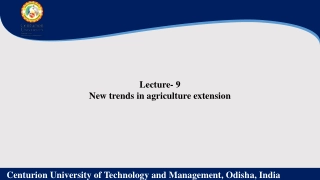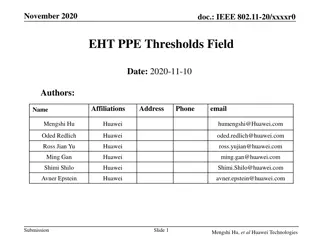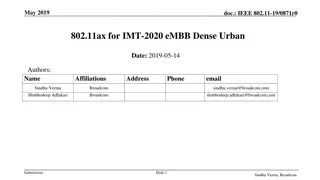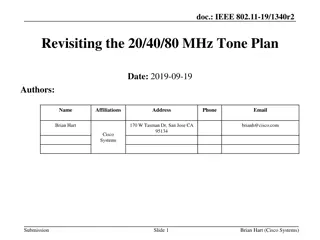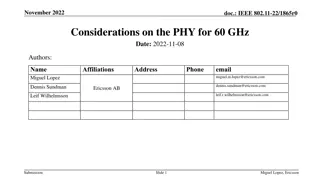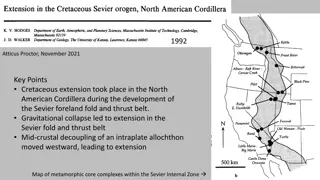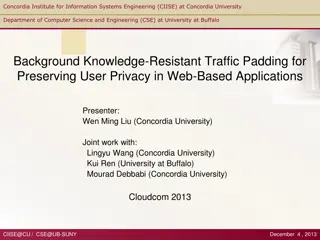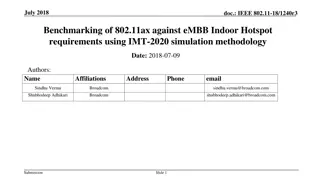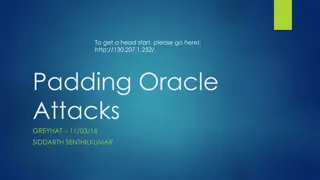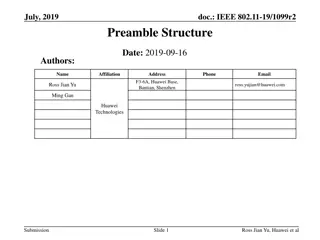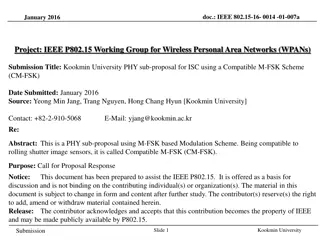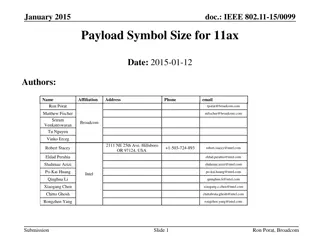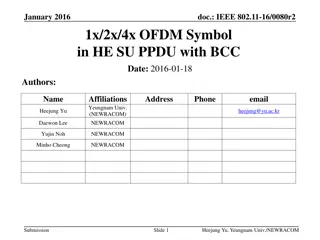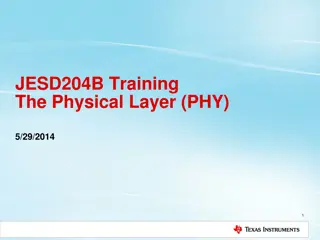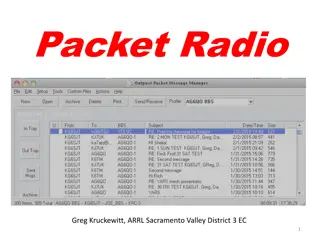Considerations on PHY Padding and Packet Extension in 11ax
The document discusses the proposed PHY padding and packet extension for IEEE 802.11ax, focusing on considerations for processing data within SIFS duration and relaxation of LDPC decoding processing time. It outlines the overview of the proposed padding scheme, considerations for LDPC implementation, and factors affecting the time required to decode LDPC encoded bits. The receiver architecture, clock speed, die area size, and other implementation factors play crucial roles in determining the processing speed, packet error rate, and power consumption.
Download Presentation

Please find below an Image/Link to download the presentation.
The content on the website is provided AS IS for your information and personal use only. It may not be sold, licensed, or shared on other websites without obtaining consent from the author.If you encounter any issues during the download, it is possible that the publisher has removed the file from their server.
You are allowed to download the files provided on this website for personal or commercial use, subject to the condition that they are used lawfully. All files are the property of their respective owners.
The content on the website is provided AS IS for your information and personal use only. It may not be sold, licensed, or shared on other websites without obtaining consent from the author.
E N D
Presentation Transcript
September 2015 September 2015 September 2015 doc.: IEEE 802.11-15/1089r0 Considerations on PHY Padding and Packet Extension in 11ax Date: 2015-09-14 Authors: Name Affiliations Address Phone email Yujin Noh Newracom 9008 Research Dr Irvine, CA 92618 9008 Research Dr Irvine, CA 92618 9008 Research Dr Irvine, CA 92618 9008 Research Dr Irvine, CA 92618 yujin.noh at newracom.com aiden.m at newracom.com daewon.lee at newracom.com minho.cheong at newracom.com heejung at yu.ac.kr Sungho Moon Newracom Daewon Lee Newracom Minho Cheong Newracom Heejung Yu Yeungnam Univ./ Newracom Yujin Noh, Newracom Submission Slide 1
September 2015 September 2015 September 2015 doc.: IEEE 802.11-15/1089r0 Abstract HE PHY padding and Packet Extension is proposed for 11ax [1]. Receiver must finish processing of the frame within SIFS . 4x OFDM symbol numerology may require faster processing speed and/or die area size increase in order to process data within SIFS. We discuss consideration aspects to the proposal. Yujin Noh, Newracom Submission Slide 2
September 2015 September 2015 September 2015 doc.: IEEE 802.11-15/1089r0 Overview of Proposed PHY Padding in [1] Example of non-STBC with a = 1 based on Max PE 16 s mode Time Last OFDM Symbol OFDM Symbol Freq. a-factor set to 1 Excess info bits + Pre FEC padding Packet Extension Post FEC Padding TPE= 4 s Pre-FEC Padding with a-factor segment boundary in the last mSTBC OFDM symbol Padding performed before encoding Post-FEC Padding up to the end of the last mSTBCOFDM symbol Padding inserted after encoding but before interleaving Packet Extension appended after the last OFDM symbol Two constellation thresholds (threshold8, threshold16,) per {BW, NSS} 3 group of PE capability with 0 s, Max PE 8 s and Max PE 16 s for each STA Yujin Noh, Newracom Submission Slide 3
September 2015 September 2015 Overview of Proposed PHY Padding in [1] (cont.) September 2015 doc.: IEEE 802.11-15/1089r0 Focused on relaxation of LDPC decoding processing time. Proposed padding scheme is not optimized for BCC. BCC has a inherently different processing flow (e.g. bit level interleaving) and proposed PHY padding in [1] may not be suitable for relaxing decoding processing time. Only NDBPS.short (excess info bits and Pre-FEC padding bits) and the first a NSD.shortare taken for LDPC encoder and LDPC decoder, respectively. NSD.short is roughly chosen as number of tones from each RU size = = N N N N N RU size 26 52 106 242 484 996 996 2 , , CBPS short SD short N SS R BPSCS NSD.short 6 12 24 60 120 240 492 , , DBPS short CBPS short Post-FEC padding bits are not processed for LDPC. Yujin Noh, Newracom Submission Slide 4
September 2015 September 2015 September 2015 doc.: IEEE 802.11-15/1089r0 LDPC Implementation Considerations Time required to correctly decode LDPC encoded bits depend on several implementation factors. Receiver architecture Target number of iterations A tradeoff between processing speed vs. packet error rate Clock speed A tradeoff between processing speed vs. power consumption Die area size A tradeoff between processing speed, power consumption vs. implementation cost Number of codewords to process in an unit time period Each vendor will optimize speed, power, and die area size according to their needs. Difficult to mandate a particular design in 802.11 standards. Number of codewords plays an important role in estimating/determining decoding processing time. 802.11 LDPC is a block encoding scheme and bits are processed in units of codeword. Yujin Noh, Newracom Submission Slide 5
September 2015 September 2015 September 2015 doc.: IEEE 802.11-15/1089r0 Simplified Rx Processing Diagram Example of Timing Relationships (BCC-nonSTBC) (N-2)th OFDM symbol (N-1)th OFDM symbol Nth OFDM symbol TPE TSIFS a = 4 N N-1 N-2 N-1 N N N-1 N-2 N-1 N N-2 TFFT+Eq+BCC interleverWR TBCC interleaver RD TBCC decoding N-1 Required processing time for a = 4 TPost-FEC TSIFS TPE a = 2 N N N Required processing time for a = 2 Yujin Noh, Newracom Submission Slide 6
September 2015 September 2015 September 2015 doc.: IEEE 802.11-15/1089r0 Simplified Rx Processing Diagram (cont d) Example of Timing Relationships (LDPC-nonSTBC) (N-2)th OFDM symbol (N-1)th OFDM symbol Nth OFDM symbol TPE TSIFS a = 4 N-2 N-1 N N-2 N-1 N N-2 N-1 N TFFT+Eq+LLR+Tone mapper WR TTone mapper RD TLDPC decoding N-1 Required processing time for a = 4 TSIFS TPost-FEC TPE a = 2 N N Two TLDPC decoder of (N-1)th and Nth after the last OFDM symbol are important to claim the proper value of Max TPE for each STA. Ncw, LLDPC and NSYM are a function of length of PSDU, NSS, NSD, constellation and R. N Required processing time for a = 2 N Yujin Noh, Newracom Submission Slide 7
September 2015 September 2015 September 2015 doc.: IEEE 802.11-15/1089r0 Simplified Rx Processing Diagram (cont d) Example of Timing Relationships (LDPC-STBC) Paired two OFDM symbols Paired two OFDM symbols (N-1)th OFDM symbol Nth OFDM symbol TPE TSIFS (N-2)th OFDM symbol (N-3)th OFDM symbol a = 4 a = 4 N-1 N N-3 N-2 (N-3) & (N-2) (N-1) & N (N-3) & (N-2) (N-1) & N Required processing time for a = 4 TSIFS TPost-FEC TPE N- 1 a = 2 a = 2 N-1 N N-3 N-2 (N-3) & (N-2) (N-3) & (N-2) (N-3) & (N-2) (N-3) & (N-2) TFFT+Eq+STBC+LLR+Tone mapper WR TFFT+Eq+Tone mapper WR TTone mapper RD TLDPC decoding Required processing time for a = 2 Yujin Noh, Newracom Submission Slide 8
September 2015 September 2015 September 2015 doc.: IEEE 802.11-15/1089r0 Analysis of LDPC Codeword Mapping Example of non-STBC with a-factor set to 3 Based on [1] Last OFDM symbol NCBPS NCBPS Case 1 LCW,1 NCBPS.SHORT APEP_Length = 5150 bytes, NSS = 2, NSD = 980, MCS=8, LCW = 1944 1 2 3 4 5 6 7 8 9 10 11 12 13 14 15 16 APEP_Length = 6150 bytes, NSS = 4, NSD = 468, MCS=9, LCW = 1944 Case 2 1 2 3 4 5 6 7 8 9 10 11 12 13 14 15 16 LCW,2 > LCW,1 Main factors in determining required processing time for LDPC is number of codewords to process. At the end of the transmission, receiver must process all the codewords in the last OFDM symbol & any unprocessed (leftover) codewords from the 2nd last OFDM symbol. In case of STBC, the codewords in the last four OFDM symbols may effect required processing time. Example) Both case 1 and case 2 require almost similar processing time, even though case 1 has Post-FEC padding to reduce bits (smaller a-factor). Although transmitted codeword length between two case is different (from shorting / puncturing / repetition), LDPC decoder processes 1944 bit block per codeword. Yujin Noh, Newracom Submission Slide 9
September 2015 September 2015 September 2015 doc.: IEEE 802.11-15/1089r0 Analysis of LDPC Codeword Mapping (cont d) Example of non-STBC with a-factor set to 3 APEP_Length = 37250 bytes, NSS = 2, NSD = 468, MCS=7, LCW = 1944 Last OFDM symbol NCBPS NCBPS NCBPS.SHORT Based on [1] codeword codeword codeword codeword codeword LCW,1 Based on 11ac rules codeword codeword codeword codeword codeword LCW,2 > LCW,1 In some cases the number of LDPC codewords is identical regardless of following 11ac padding rules (i.e. always a=4) or following padding rules proposed in [1] (i.e. a-factor 2 or 3). Especially when codeword density is less than four codewords per OFDM symbol. Yujin Noh, Newracom Submission Slide 10
September 2015 September 2015 September 2015 doc.: IEEE 802.11-15/1089r0 STBC Last 2 OFDM symbol in STBC TPE a = 2: Pre-FEC Padding bits Pre-FEC Padding bits Excess Info bits Post-FEC Padding bits Excess Info bits Post-FEC Padding bits Packet Extension Tpost-FEC Tpost-FEC In BCC/LDPC, one of the TPost-FEC is wasted and is required to process twice the number of bits/codewords at the end of the last OFDM symbol. STBC is rate 1 scheme, therefore received bits/symbols are processed in pair of OFDM symbol (i.e. two OFDM symbol). Therefore, receiver must buffer twice the amount of received bits before being able to process them. Yujin Noh, Newracom Submission Slide 11
September 2015 September 2015 September 2015 doc.: IEEE 802.11-15/1089r0 Some Finding on a-factor Configuration There are instants where using a-factor 3 (or sometimes even a- factor2) doesn t reduce the number of codewords to be processed by LDPC. Some examples in the table below. # of CW 15/0810 # of CW 11ac APEP Length # of SS # of SD MCS a-factor 3 3 3 3 3 27 54 6 6 6 27 54 6 6 6 5250 9550 750 850 950 2 2 2 2 2 468 468 468 468 468 9 8 5 6 7 3 3 3 3 3 3 158 208 366 345 245 345 158 208 366 345 245 345 31750 37650 66550 69550 39550 55650 2 2 1 1 1 1 468 468 980 980 980 980 9 8 6 7 5 5 3 552 552 89250 2 468 5 3 110 110 21950 2 468 7 Yujin Noh, Newracom Submission Slide 12
September 2015 September 2015 Some Finding on a-factor Configuration (cont d) September 2015 doc.: IEEE 802.11-15/1089r0 Required processing time last OFDM symbol (non-STBC) Secured processing time a = 3: Post-FEC padding bits Pre-FEC padding bits Excess Info bits Packet Extension Secured processing time Processing time thought to have saved The 4us (or 8us) extra decoding relaxation time (TPost-FEC) thought to be available from use of a-factor 3 (or a-factor 2) may not exist depending on PSDU size, number of spatial stream, MCS, and RU size. Yujin Noh, Newracom Submission Slide 13
September 2015 September 2015 September 2015 doc.: IEEE 802.11-15/1089r0 Summary Depending on receiver design, SIFS (16us) may not be enough to fully process all received bits. Relaxing decoding processing time, with use of Post- FEC padding requires further analysis. BCC/LDPC receiver is a complex system and reduction in processing time by use of a-factor cannot be linearly modeled by reduction in number of encoded bits in the last OFDM symbol. We encourage members and vendors to further check implementation consideration aspects for PHY padding methodology proposed in [1] before agreeing on concepts therein. Yujin Noh, Newracom Submission Slide 14
September 2015 September 2015 September 2015 doc.: IEEE 802.11-15/1089r0 References [1] 11-15-0810r0, HE PHY Padding and Packet Extension Yujin Noh, Newracom Submission Slide 15


